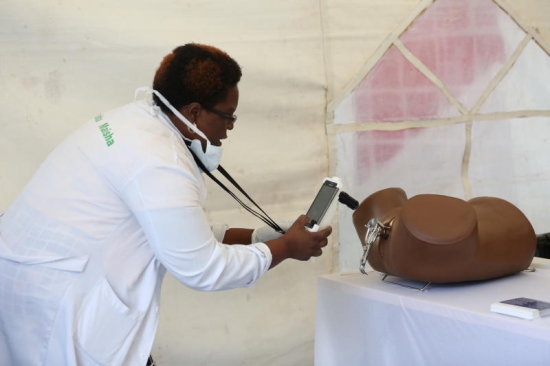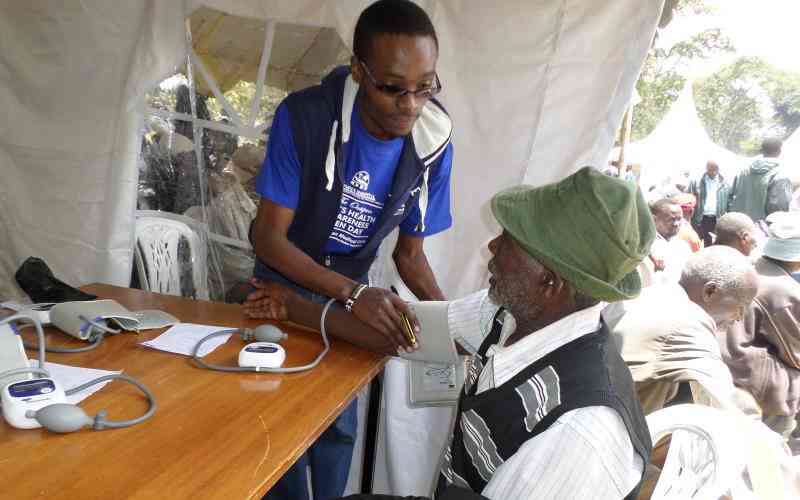
As the world relies on technology to make disease diagnosis timely and efficient, checking for cervical cancer has been made easier, thanks to a new device.
Using a smartphone that enhances visual inspection of the cervix, the device was effectively used at a recent public cervical cancer screening at the Kenyatta International Convention Centre in Nairobi.
Known as a colposcope, the non-invasive device developed by Israelis Ariel Beery and David Levitz was one of the reproductive health gadgets anticipated to enable health workers make faster, accurate and recordable diagnosis.
If adopted by the national and county governments, and private practitioners, it will improve screening rates for cervical cancer and enhance early treatment.
Mr Beery and Mr Levitz are optimistic that the device will strengthen World Health Organisation’s (WHO) “screen-and-treat” standard-of-care guidelines that encourage prompt correct diagnosis and immediate treatment.
Speaking on the sidelines of an international reproductive health meeting hosted by First Lady Margaret Kenyatta, Lucy Kanja, a nurse at Mbagathi Hospital in Nairobi, says the device has enabled her interpret examination results faster.
Images are magnified
Previously, health workers viewed the cervix with the naked eye to identify colour changes, but the gadget enhances screening as the images are magnified and could be recorded using this hand-held mobile device.
Ms Kanja says the device’s recording and storage capacity helps health workers save the image to a patient’s record, and consequently use the same for teaching and consultation purposes.
“I noticed a suspected case of cervical cancer and instead of calling my colleague from another tent to come and observe, I took a photo and when she viewed it, she confirmed my diagnosis,” she told The Standard on Saturday.
Kanja said the device also sparked a cordial reproductive health conversation with the client by showing them images and explaining the results.
“It is easier to explain to the client the results of the screening by viewing the photos on the smartphone,” she noted.
The device should not touch the client’s body and should be positioned at about three to six inches away.
Curtis Peterson from Mobile Optical Detection Technologies says the device uses CervDx app and CervCenter management website to provide informed decisions on examination of a client.
It has a rechargeable battery for 12 hours of continuous imaging, Wi-Fi and cellular data compatibility, and the ability to store offline patient image of up to 2,000 cases.
The visual inspection kit runs on an android phone and has a light system with a cross polarisation system to reduce glare during examination with its estimated cost at about Sh150,000. About 50 have sold in Kenya already.
Inadequacy of screening programmes as well as lack of awareness of the disease in developing countries has been cited as the lead cause of cervical cancer deaths.
Health experts point a finger at persistent or chronic infection with one or more types of the high risk human papillomavirus (HPV) as the primary cause of cervical pre-cancer lesions and cancer.
Cervical cancer is the most common in Africa and according to WHO, in 2012, over half a million new cases of cervical cancer were diagnosed worldwide with one in five being in sub-Saharan Africa.
A recent mobile phone survey by University of Nairobi trainee doctor Mellany Murgor found out a gross unawareness of cervical cancer among participants with friends and relatives as the most preferred source of information.The survey comprised 70 per cent women and 30 per cent men aged between 17 and 30 and gauged their knowledge on the reproductive health disease.
Kenya Cancer Association official David Makumi advised that because treatment for cervical cancer is individualised for disease stage, and involves a combination of approaches, the earlier the cancer is detected, the less aggressive the treatment is likely to be.
“Cervical cancer deaths are avoidable, effective roll out of a national cervical cancer screening programme, adequate funding and aggressive public education and prompt treatment of women with pre-cancerous lesions will help reduce the deaths,” Mr Makumi said.
 The Standard Group Plc is a multi-media organization with investments in media platforms spanning newspaper print
operations, television, radio broadcasting, digital and online services. The Standard Group is recognized as a
leading multi-media house in Kenya with a key influence in matters of national and international interest.
The Standard Group Plc is a multi-media organization with investments in media platforms spanning newspaper print
operations, television, radio broadcasting, digital and online services. The Standard Group is recognized as a
leading multi-media house in Kenya with a key influence in matters of national and international interest.











